Bathroom skirting boards
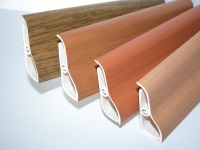
In the past, bathroom arrangement was quite simple. The room itself had a bathtub, a small-sized sink, and a washing machine. The walls were painted or tiled and no skirting boards were used. The joints between the finishing materials were grouted with cement mortar or putty.
Joints were painted annually to prevent moisture from seeping through. Cement-based joint treatments have now been replaced by plastic or ceramic skirting boards. In terms of performance and price, this material is available in a wide range.
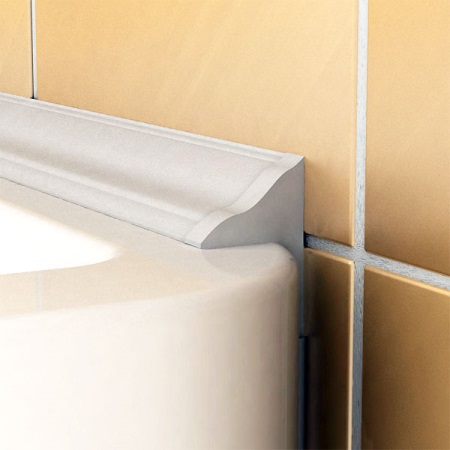
It prevents the penetration of moisture in the joints between the wall surface and the bathroom itself. This saves expensive finishing materials from damage and increases the aesthetic appeal of the bathroom.
Need
Ceramic or conventional skirting is used in the design of the floor and ceiling of the bathroom. It is easy enough to install and perfectly withstands frequent temperature fluctuations and high humidity.
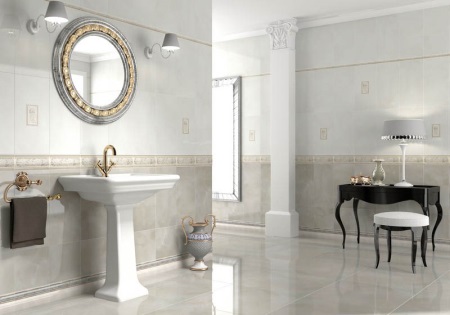
At the joints of the bathtub itself with the walls to prevent moisture and mold, special skirting boards or borders are used. Also, this finishing material is framed flooring with uneven edges, and pressed to the surface of the floor coating made of linoleum.
In some types of baseboards, you can lay and hide electrical wires or make the floor plinth warm.

This suggests that modern skirting is quite a functional element of bathroom decoration. Nowadays, the skirting board is also a decorative detail that gives the interior of this room a finished look.
Ceiling and floor skirting boards
Baseboards give the bathroom a neat appearance and reliably protect joints with plumbing from moisture and mold formation. There are different types of floor skirting:
- wooden
- plastic
- laminated
- veneered
The material is chosen depending on the type of surface that will be connected with it. Currently, it is considered popular plastic floor plinth, which is available at a cost to many buyers.
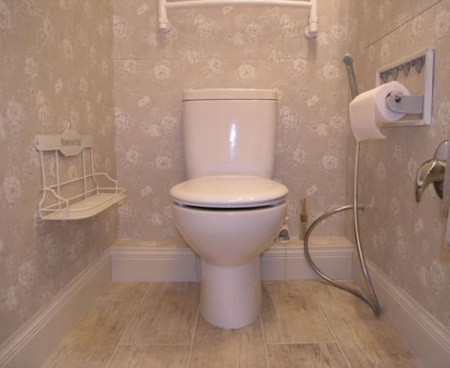
The material of manufacture of ceiling plinth is:
- polyurethane
- foam plastic
- wooden base
- plastic
Plastered ceiling in the bathroom is often decorated with a wooden skirting board, but it quickly cracks from high humidity. The choice of ceiling plinths should be carried out with the entire project in mind, as this element must necessarily be in harmony with the rest of the surrounding surfaces.
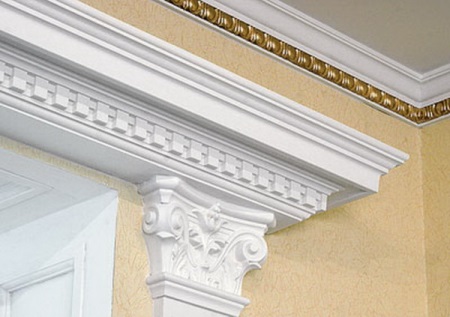
Plastic edging
Plastic curb, which is installed in the bathroom, is a lightweight waterproof corner profile. It can be 250 centimeters long.
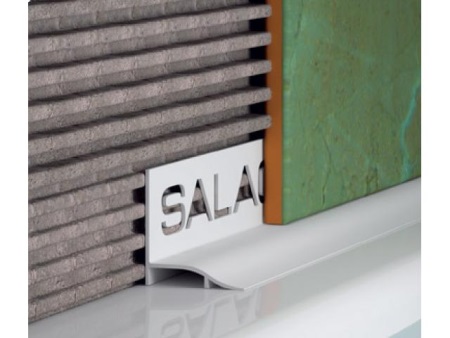
The edging is used to mask the joint between the bathroom and its wall and to protect it from the ingress of moisture. It can be installed under the ceramic tile, that is, before it is glued to the wall, and can also be adjacent to it. Therefore, this material is subdivided into internal and external.
Nowadays manufacturers produce borders that have rubberized edges for moisture protection and airtight installation. They are sold together with completing fittings, which consist of designed to connect the corners of the plugs and other elements.
Ceramic skirting boards and corners
Corner ceramic, which is installed in the bathroom, has a non-porous structure and wear resistance, so it is durable and does not deform over time. Unfortunately, the ceramic corner is prone to mechanical damage. It splits easily, even from a minor blow. In addition, the corner is quite difficult to install - with its help it is quite difficult to repeat various curves and asymmetric shapes. It is difficult to use on irregularly shaped bathtubs.
With a decorative skirting made of ceramic tiles you can make color accents, dilute or support the overall style of the interior. It can be installed both on and under the tiles.

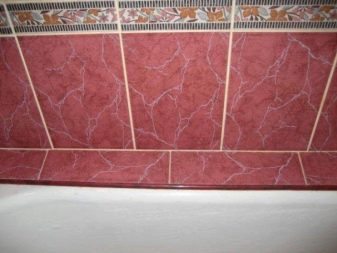
Marble borders
Borders made of marble have a beautiful appearance and characteristics. They are durable elements that reliably protect the joint from moisture. Also, borders are used as elite decorative elements to decorate the room.
The disadvantage is their combination with other finishing materials, because marble borders rarely match the standard interior, but can bring a spirit of luxury and exclusivity in any interior, but usually this kind of border is chosen under expensive finishing materials, such as: natural stone, mosaic, agglomerate.
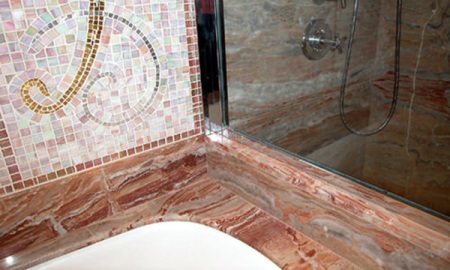
When choosing a marble curb, the installed bathtub must also match. A small, ordinary bathroom will look strange framed with a marble curb. In addition to its beauty, marble borders are characterized by high quality characteristics, durability, and the biggest disadvantage is the high cost of this material.
Edging strip
Curb tape is currently considered the most in-demand material, which provides sealing of joints between household plumbing fixtures and various surfaces. Edging tape is easy to assemble, and the low cost makes it accessible to any buyer.
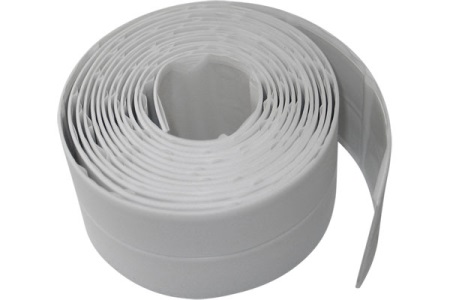
Polyethylene waterstop-tape does not deform under different loads, is resistant to household chemicals and damage during operation.
Due to the use of special glue, the tape adheres tightly to any glossy smooth surfaces. Its main disadvantage is its intolerance to acidic silicones, which causes the tape to warp and come off the surfaces. This fact must be taken into account when installing the curb tape. Also another disadvantage is considered to be its short life. The tape requires replacement after three years after installation.
Fixing the skirting tape
The skirting is glued to the joint with a special glue or a moisture-resistant silicone sealant. It can also be "liquid nails". Usually, lightweight plastic skirting boards are glued to sealantHeavy ceramic or stone ones require the use of liquid nails.
The sequence of steps in fixing the baseboard:
- Thorough cleaning of the joint from dirt and dust
- Drying of joint and surrounding surfaces
- Glue or sealant application
- Pressing the boards together firmly
Installing the skirting board on the perimeter of the bathtub
Sequence of actions when installing a skirting board on liquid nails:
- Determining the level of the floor and walls, since the fixing of the skirting board with liquid nails requires a perfectly even surface
- Determining the 90 degree corners in the room with the help of an angle measure
- Measuring the perimeter of the bathroom with a tape measure
- Applying liquid nails to the back of the baseboard and sticking it to the wall with the joints connected
- Pressing the baseboard down with something heavy to make it stick better
- Fixing the skirting boards all around the room.
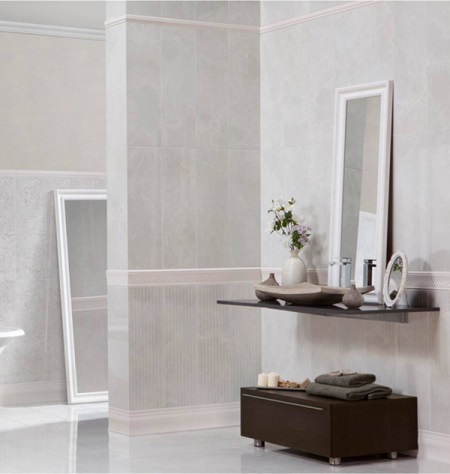
Fixing the skirting boards on the ceiling and the floor
Attaching the ceiling or floor skirting boards requires an adhesive that is used for gluing modern ceiling tiles. Trimming the ends of the skirting board is a rather difficult step, so that the ends fit together correctly during installation.
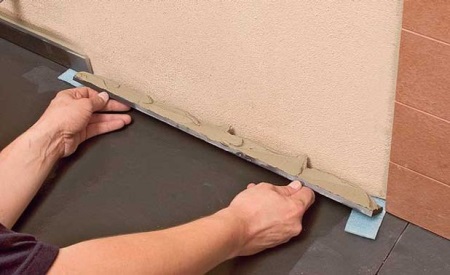
A stationery knife is used to cut the baseboard. Adhesive is applied in the form of a thin strip to the surface of the material, and then the skirting board is glued to the surface. Any excess glue is removed with a dry sponge or clean cloth. Attention and care is required when attaching the last skirting board. This skirting board fits the length first and is cut at a 45 degree angle, which ensures a good joint and prevents gaps and holes. If they do appear, a light silicone sealant is used to get rid of them.
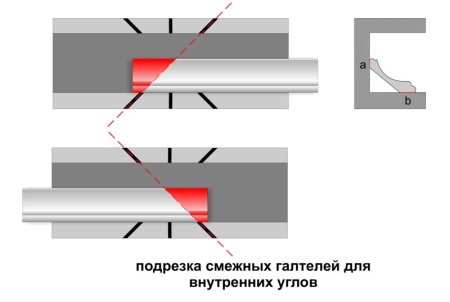
Self-adhesive skirting board installation
Self-adhesive skirting boards require less effort to install. The protective strip is removed from its adhesive side and the skirting board is then pasted onto the installation area. A trowel is used to mark a right angle when installing self-adhesive tape. The disadvantage of self-adhesive skirting is its short lifespan.
An important condition for installation is the surface, which must be properly prepared, that is, aligned and dried. If this is not done, moisture can get under the baseboard.





Border tape - a temporary solution, it is better to buy a skirting board.